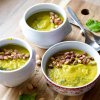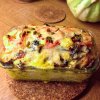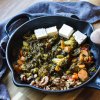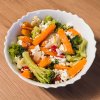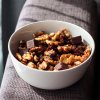JUMP TO
Learn what are the best strategies for transitioning to a vegetarian diet that is also low-carb, and how to keep it consistent and healthy. I’ll share with you my own experience with a low-carb vegetarian diet and what I’ve learned after 2 years of eating like this.
Before moving forward, I want to make it clear that it’s not my intention to convince you of anything, including vegetarian diets. For me, transitioning to a vegetarian low-carb diet was a natural thing and since then I’ve discovered huge health benefits associated with this type of eating.
I’m writing this article because I want to share with you my own experience and insights that might help you in your own journey of finding real food freedom.
What is the Vegetarian Diet?
Short answer: A way of eating focused on avoiding all meat, fish and poultry, as well as foods that contain them.
Long answer: Vegetarian diets refers to a different way of eating compared to what we may call a ‘regular’ way of eating. A classic vegetarian diet excludes all meat, fish and poultry, as well as all the foods that contain them. This means, vegetarians also avoid animal fats of any kind, as well as products that contain traces of these products. Simply put, any product that was obtained by means of killing the animal should be avoided.
There are a few variations to the classical vegetarian diet, as follows:
- Lacto-ovo-vegetarian – This is the “classical” vegetarian diet that we all know and refer to when we’re using the term ‘vegetarian diet’. As I was explaining above, this classical vegetarian diet allows for eating all kinds of plants, eggs and dairy products, while excluding all meat, fish, and poultry, as well as foods that contain them.
- Lacto-vegetarian – This variation excludes all meat, fish, poultry and eggs. All kinds of plants and dairy products are allowed.
- Ovo-vegetarian – This variation excludes all meat, fish, poultry and dairy products. All kinds of plants, eggs and products containing eggs are allowed.
- Vegan – You’ll be surprised to know that the vegan way of eating is actually part of the vegetarian diet. It makes sense if you think that a vegan diet basically excludes all animal products, including eggs and dairy.
What is the Low-Carb Diet?
Short answer: A low-carb diet refers to a way of eating where the focus is on keeping your total carbs intake under 100-150g per day.
Long answer: A low-carb diet is a way of eating where daily consumption of carbohydrates doesn’t exceed 100-150g per day (excluding fiber). This means that in a low-carb diet you’ll be focusing your efforts on eating plenty of healthy fats and adequate protein, while limiting the sources of carbs to mostly vegetables, some legumes and some fruits.
It’s important not to mistake a low-carb diet with the ketogenic diet. A ketogenic diet is by definition a low-carb diet, where the carbohydrates are very restricted. In a ketogenic diet, the focus would be on achieving a state of nutritional ketosis, thus producing ketones (a byproduct of the body breaking down fat for energy). This can be achieved by keeping the total daily carbs intake under 50g (excluding fiber). Ketogenic diets can have numerous health benefits and can also be harder to implement, and definitely hard to maintain for long periods of time.
Why a Low-Carb Vegetarian Diet?
A low-carb vegetarian diet combines the benefits of eating low-carb with what a vegetarian diet has to offer. This means eating a diet that is rich in plants, dairy and eggs, while avoiding all meat, fish and poultry (and all foods that contain them). The focus is on eating plenty of whole foods that are rich in all kinds of nutrients.
What I like about eating low-carb and vegetarian, is that I can take the benefits of a low-carb diet and extend them to a vegetarian way of eating. If you think about it, a vegetarian diet simply means eating anything besides meat, fish and poultry. There is no mention of the quality of the ingredients or the way the meals are prepared.
Adding the principles of low-carb on top of the vegetarian diet leads to a healthier approach compared to the classical vegetarian diet. All of a sudden, the focus shifts towards the quality of the foods you’re eating and that’s very important in terms of health benefits.
Here are some of the health benefits associated with eating a low-carb vegetarian diet:
Eating more vegetables – If there’s one thing that all nutrition experts agree on, it’s eating more vegetables. Vegetables are naturally low-carb and packed with all sorts of nutrients so they’re perfect for your purpose here. Since transitioning to a vegetarian diet, I learned how to include more plants in all my meals. Not only I discovered new plants and new combinations, but my plate looks awesome every time.
More nutrients – There are numerous studies showing that plant-based diets (eg: diets rich in plants) are healthier because you’re getting more nutrients per serving. We know this already. The fact is, eating a wide array of plants means you’ll be easily getting all your vitamins, minerals, enzymes, healthy fiber and phytonutrients. Making sure that you wash the plants properly is something very important, even more important than eating organic all the time.
Health benefits – Ever since I’ve started eating a vegetarian diet 2 years ago, I saw my health improving right before my eyes. I now have a steady stream of energy all day long, I can fast easier and longer, I can train better and recover faster. I digest the food better and I have regular bowel movements (2-3 times/day like clockwise). Not to mention that I am definitely sleeping better, my moods have virtually disappeared, and I can focus better when I’m working.
Creative meals – Previously to approaching the vegetarian way of eating, I was focusing all my meals on meats. A meal would always start with a piece of meat, followed by an optional serving of vegetables. That was ok for the time, but now I can do way better, Now my plate is made up of a mix of colorful vegetables, french cheeses, maybe some eggs, fruits and so on. The food looks awesome and tastes amazing every time.
Plant based healthy fats – Instead of focusing only on animal fats, I learned how to eat more plant-based healthy fats with every meal. Things like avocado and olives are always on my plate, while snacking on all kinds of nuts and seeds has become a habit for me. I’m not saying that animal fats aren’t healthy, and I certainly don’t think cholesterol is bad for you, I’m just saying that I now have more options available.
More nutrients – Before starting to eat vegetarian and low-carb, I was under the impression that meat is everything in terms of nutrition. I was afraid to quit meat because I didn’t know what to expect in terms of nutrients. I was literally afraid to make the change. What if I couldn’t get my proteins? What if I won’t be able to eat enough? Turns out that I was wrong all the time. Not only that I eat less now, but I can easily get all the nutrients I need.
Healthier meals – Unless you’re growing your own cows, pigs or chickens, most of the animals these days are fed unhealthy diets and antibiotics. For me personally, it was becoming harder and harder to find healthy meats, that being one of the reasons I decided to change my way of eating. It’s simply safer and cheaper to avoid meats, while concentrating on eating plenty of plants, healthy cheeses and eggs.
Help the environment – Bottom line: there is too much meat available everywhere and this harms the environment more than you and me realize. We’re talking about all the animal waste, all the resources used to grow these animals, or the way most of these animals are treated.
How to Implement a Low-Carb Vegetarian Diet
With the popularity of low-carb diets increasing, you may be wondering if such a diet can be managed easily using a vegetarian approach (aka low-carb vegetarian)? After all, many of the recipes out there focus on meats and meat products. Don’t worry, I’ll show you how to eat vegetarian low-carb meals that are amazingly healthy.
There are some strategies and I’ll share them with you in just a minute. But the most important advice I can give you is quite simple: Eat Real Food. Because why not … Real food is loaded with all the nutrients that your system needs. Everything is there, easily available. Nutritious. Healthy. Food. At the same time, stay away from processed foods, because that is not a healthy way to be a vegetarian.
Here are my strategies for managing a low-carb vegetarian diet:
Include plant-based fats with every meal. Things like avocado and olives taste great with pretty much anything. Don’t forget about nuts and seeds, they work great as snacks but are also great when added to meals, as a side. You can also use healthy plant-based oils, things like extra virgin olive oil, avocado oil or coconut oil. These are great cooking oils that also work great in salads.
Eat more lightly prepared meals. Try eating meals that aren’t heavily cooked. Since you don’t have to cook meat anymore, you can start being creative with your meals. Try experimenting with things like lightly cooked vegetables, lots of salads, Indian food, cheeses, anything with eggs, raw veggies, low-carb desserts, simple snacks and healthy sandwiches.
Eat cheeses that are high in fats. If you like true artisan cheeses (hard or soft) now you have a chance to enjoy them even more. They bring texture, taste, but also nutrients (fats, proteins, vitamins, probiotics) to any meal. I live in Europe where I’m lucky enough to be able to enjoy many French cheeses like Brie and Camembert, but I also appreciated things like Gouda, Mozzarella, Parmesan, Cheddar, etc.
Low-carb desserts are a lifesaver. Good news is that all low-carb desserts are so easy to prepare and so nutritious, making them perfect snacks or even meal replacements. Think low-carb pancakes, muffins, cakes, low-carb chocolate, even vegan ice cream or smoothies.
Avoid soy, wheat and corn. Many vegans and vegetarians turn to soy as a way to get protein in their diet. Unfortunately, while soy can be a good source of proteins on paper, in order to be healthy one must ferment soy (natto). As for wheat and corn, they should be avoided unless you control the sources. This makes sense since both wheat and corn are high in carbs and insoluble fiber, without any important nutrients per serving. Considering that these crops can also be genetically modified, I would advise against them.
Keep wheat to a minimum. There is no point in replacing meat with bread or pasta. As with any low-carb or keto diet, keep wheat to a minimum and try choosing healthy variations (eg: low-carb pancakes, muffins, etc). Think of pasta and bread more like a treat for special occasions, instead of a regular meal.
Eat broccoli and cauliflower. In my opinion, broccoli and cauliflower are two super vegetables that aren’t getting the reward they deserve. They are loaded with vitamins, minerals, antioxidants and plenty of fiber. They have a great texture, can be eaten with pretty much anything and are so easy to cook. Plus frozen broccoli and cauliflower are great in smoothies or nice creams.
Eat beans and rice. Beans and rice shouldn’t be the focus of your diet, but I like them because they contain a type of fiber called resistant starch. As long as you eat them cooked and cooled, you’ll get plenty of resistant starch, which is basically food for your gut bacteria (prebiotics). Worried about their glycemic index? Just make sure to include a source of healthy fats with every meal, this way the glycemic will be lower.
Prepare your own meals. The best way to make sure that you’re staying in control of your health, is to cook your own meals. Nowadays I’m a big fan of eating lightly cooked meals, where I choose to combine together various cooked vegetables, French cheeses, plant based healthy fats, maybe some low-carb bread, some dried fruit, some frozen berries and plenty of raw veggies (bell peppers, tomatoes, cucumber, different types of onions and garlic, and so on).
Eat plenty of healthy fiber.. All plants come with lots of fiber (soluble, insoluble and resistant starch). Most of that fiber is food for your gut flora, which translates into a wide range of health benefits associated with a short-chain fatty acid called butyrate. These health benefits include improved digestion, insulin sensitivity, repairing of the gut lining, improved cardiovascular markers, reduced inflammation and many others.
Avoid all unhealthy options. Regardless of your way of eating, it’s important to be in control of exactly what you’re eating. Things like additives, preservatives, fillers, added sugars or refined seed oils shouldn’t be part of anything called food.
Read more: Healthy Vegetarian and Vegan Meal Ideas for people that can’t cook.
How to Keep It Healthy
In the last few years I’ve learned that it’s far more important to focus on the sources and the quality of foods, instead of focusing on macros. The quality of the foods we eat can make or break our health, so it’s equally important to make sure that our food is loaded with beneficial nutrients.
Here are some guidelines I use to make sure that the foods we’re eating every day are indeed healthy:
- Eat whole foods, while avoiding processed foods of any kind. Processed foods generally lack beneficial nutrients while being packed with sugars, refined oils and other nasty chemicals.
- Concentrate on eating lots of different plants, with a focus on vegetables. This way you’ll eat a nutrient dense meal every time.
- Frozen plants are always fresh and pack the same nutrients as fresh plants, plus you can find lots of frozen veggies and berries at affordable prices.
- If possible, choose organically grown foods (plants, eggs, dairy) as opposed to conventionally grown. These will have more nutrients compared to conventionally grown, plus you also avoid pesticide residues which can be high in some categories of plants.
- Choose whole foods, as fresh as possible, unprocessed and unrefined. This way you’ll maximize your intake of healthy nutrients.
- Choose products from responsible sources. This translates to a better choice towards the environment (soil, water, air, land or the animals) but also for your health.
- Keeping your fridge and pantry stocked with healthy foods, including low-carb snacks and fruits, will help you stay away from unhealthy options.
- Make it a priority to cook your own meals, this way you’ll be sure that what you’re eating is top quality food.
Read More: Foods to Eat on a Low-Carb Vegetarian Diet
Bonus Tips:
- Always read the labels, identify hidden ingredients and avoid them.
- Avoid additives and preservatives; they are proven to negatively impact health.
- Avoid refined seed oils and all added sugars (refined sugar, raw sugar, artificial sweeteners, and sugar alcohols). They’re toxic for your system, leading to oxidative stress which leads to inflammation. and ultimately disease.
- Avoid foods that are highly processed and ultra pasteurized. They lack even the basic nutrients, and some of them can even be harmful for your health.
- Sugar, wheat, industrially processed oils, GMOs and processed foods are not real foods.
Read More: Check out my tips for eating healthy foods all the time.
Conclusions
Vegetarian diets are a popular way of eating more plants while staying away from meat products. Low-carb diets are very popular these days and numerous studies highlight different health benefits associated with this way of eating.
Low-carb diets are focused on keeping the carbs low, while also eating various meats, fish and poultry. The keto diet is a variation of the low-carb diet, where the carbohydrates are restricted even more.
A low-carb vegetarian diet, where one eats plenty of plants, eggs and dairy, can be an alternative solution to the classic low-carb way of eating.
In the end it’s all about your needs and your health goals. In my opinion, diets shouldn’t be seen as strict regimented regimes, instead we can use diets as frameworks that make it easy for us to focus on a specific health goal. In the end, I believe that it’s far more important to focus on eating real foods instead of focusing on a certain diet.
I hope that I inspired you to eat healthier, showing you that a low-carb vegetarian way of eating is indeed possible, if that’s something you’d like to experiment with.
Do you have experience with a vegetarian low-carb diet? What are your best tips? Share below.










